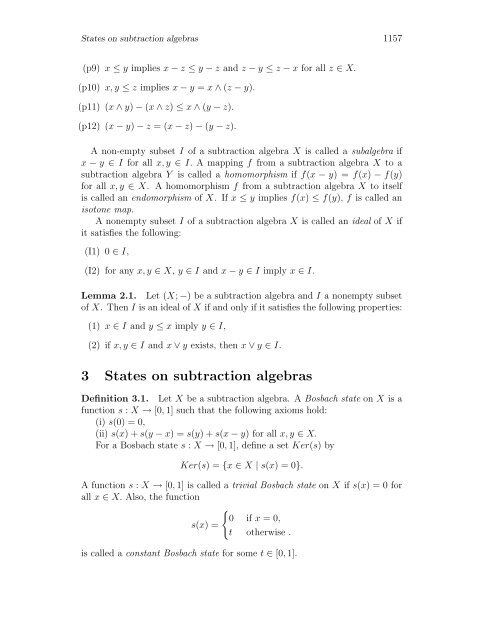States on Subtraction Algebras 1 Introduction
States on Subtraction Algebras 1 Introduction
States on Subtraction Algebras 1 Introduction
Create successful ePaper yourself
Turn your PDF publications into a flip-book with our unique Google optimized e-Paper software.
<str<strong>on</strong>g>States</str<strong>on</strong>g> <strong>on</strong> subtracti<strong>on</strong> algebras 1157<br />
(p9) x ≤ y implies x − z ≤ y − z and z − y ≤ z − x for all z ∈ X.<br />
(p10) x, y ≤ z implies x − y = x ∧ (z − y).<br />
(p11) (x ∧ y) − (x ∧ z) ≤ x ∧ (y − z).<br />
(p12) (x − y) − z =(x − z) − (y − z).<br />
A n<strong>on</strong>-empty subset I of a subtracti<strong>on</strong> algebra X is called a subalgebra if<br />
x − y ∈ I for all x, y ∈ I. A mapping f from a subtracti<strong>on</strong> algebra X to a<br />
subtracti<strong>on</strong> algebra Y is called a homomorphism if f(x − y) =f(x) − f(y)<br />
for all x, y ∈ X. A homomorphism f from a subtracti<strong>on</strong> algebra X to itself<br />
is called an endomorphism of X. Ifx ≤ y implies f(x) ≤ f(y), fis called an<br />
isot<strong>on</strong>e map.<br />
A n<strong>on</strong>empty subset I of a subtracti<strong>on</strong> algebra X is called an ideal of X if<br />
it satisfies the following:<br />
(I1) 0 ∈ I,<br />
(I2) for any x, y ∈ X, y ∈ I and x − y ∈ I imply x ∈ I.<br />
Lemma 2.1. Let (X; −) be a subtracti<strong>on</strong> algebra and I a n<strong>on</strong>empty subset<br />
of X. Then I is an ideal of X if and <strong>on</strong>ly if it satisfies the following properties:<br />
(1) x ∈ I and y ≤ x imply y ∈ I,<br />
(2) if x, y ∈ I and x ∨ y exists, then x ∨ y ∈ I.<br />
3 <str<strong>on</strong>g>States</str<strong>on</strong>g> <strong>on</strong> subtracti<strong>on</strong> algebras<br />
Definiti<strong>on</strong> 3.1. Let X be a subtracti<strong>on</strong> algebra. A Bosbach state <strong>on</strong> X is a<br />
functi<strong>on</strong> s : X → [0, 1] such that the following axioms hold:<br />
(i) s(0) = 0,<br />
(ii) s(x)+s(y − x) =s(y)+s(x − y) for all x, y ∈ X.<br />
For a Bosbach state s : X → [0, 1], define a set Ker(s) by<br />
Ker(s) ={x ∈ X | s(x) =0}.<br />
A functi<strong>on</strong> s : X → [0, 1] is called a trivial Bosbach state <strong>on</strong> X if s(x) = 0 for<br />
all x ∈ X. Also, the functi<strong>on</strong><br />
{<br />
0 if x =0,<br />
s(x) =<br />
t otherwise .<br />
is called a c<strong>on</strong>stant Bosbach state for some t ∈ [0, 1].
















